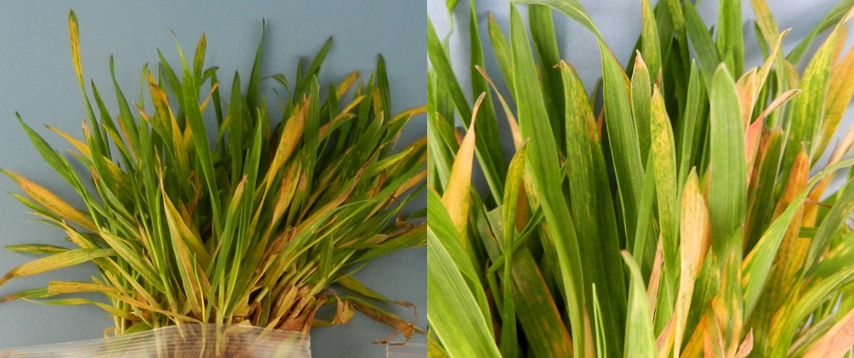Symptoms caused by wheat streak mosaic virus (WSMV) on wheat growing in Indiana may include yellowing, stunting, and curling of leaves due to feeding by the wheat curl mite, the primary vector of WSMV. Time of infection and environmental conditions will determine severity of disease; warm, dry conditions favor WSMV due to an increase in the wheat curl mite population. Wheat curl mites can transmit the virus for up to a week after feeding on an infected plant and generally move in the wind from one plant to another in a field. Early colonization of the wheat by the wheat curl mite can lead to a more pronounced WSMV symptom development, premature plant death, and greater yield loss.
Barley yellow dwarf virus (BYDV) has many different strains that can infect more than 150 different grass species, including wheat, oats, barley, rice, and corn. These viruses are vectored by aphids. Once an aphid acquires the virus by feeding on an infected host it can transmit the virus to a new host for two to three weeks. It will take two to three weeks for symptoms to appear in wheat after the initial infection while fall infections may not appear until the following spring. Symptoms of BYDV in wheat include stunted tillers and roots and discolored foliage. A reddish discoloration usually starts at the tip of the flag leaf and moves downward; eventually in wheat the leaves may appear yellow, red, or purple in color. BYDV infection can lead to reduced tillering, poor flowering and kernel sterility or failure to fill.
Management Options for Wheat Viruses
There are no control options to reduce viral symptoms in currently infected plants. However, accurate diagnosis of wheat viruses is important for future disease management plans. Healthy plants can better tolerate infection, so it is important to manage other foliar diseases in wheat and maintain adequate moisture and nutrients.
Many wheat varieties are available that have partial resistances to one or more of these wheat viruses and/or their vectors. Understanding a field’s risk for a specific virus can aid in variety selection down the road, as planting a less susceptible variety is the first line of defense in viral disease management.
Removal of volunteer wheat or other grasses late in the season may also help reduce the “green bridge” for the vectors or virus survival into the next season.
If you suspect viral infection, a sample can be submitted to the Purdue Plant and Pest Diagnostic Lab (PPDL). The PPDL can test for the presence of ten wheat viruses. They include five strains of barley yellow dwarf virus (BYDV; strains PAV, MAV, RMV, SGV, and RPV); wheat spindle streak mosaic virus (WSSMV); soilborne wheat mosaic virus (SBWMV); wheat streak mosaic virus (WSMV); high plains virus (HPV) and Triticum mosaic virus (TriMV). The cost of the wheat virus screen is $50, in addition to the usual sample handling fee of $11 for in-state samples and $22 for out-of-state samples.
For more information see Purdue Extension publication “Diseases of Wheat: Wheat Viruses”


